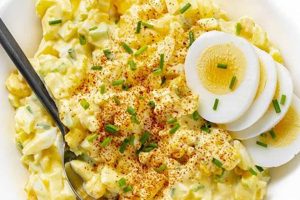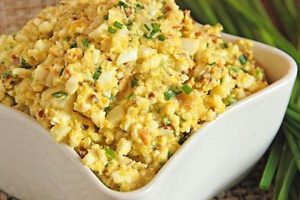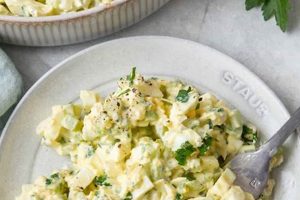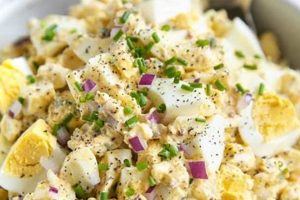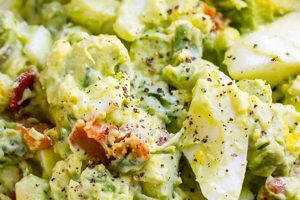A superior egg salad formulation involves carefully balancing key ingredients like eggs, mayonnaise, and seasonings to create a harmonious blend of flavors and textures. A classic example utilizes hard-boiled eggs, finely chopped celery and onion, a creamy mayonnaise base, and subtle additions of mustard, salt, and pepper. Variations can include incorporating fresh herbs like dill or chives, or adding a touch of sweetness with relish or pickle.
Achieving a desirable egg salad provides a versatile and nutritious dish suitable for various occasions. It serves as a quick and satisfying lunch, a component in sandwiches and wraps, or a flavorful appetizer on crackers or toast points. Historically, egg salad has evolved from more elaborate composed salads, offering a simple yet elegant culinary solution. Its enduring popularity stems from its adaptability, ease of preparation, and readily available ingredients.
Exploring the nuances of ingredient selection, preparation techniques, and flavor combinations provides a pathway to creating a truly exceptional egg salad experience. This involves examining factors such as egg cooking methods, mayonnaise choices, and the balance of seasonings and add-ins, ultimately leading to a personalized and satisfying culinary creation.
Tips for Exceptional Egg Salad
Creating a truly remarkable egg salad involves attention to detail and a thoughtful approach to ingredient selection and preparation. These tips offer guidance for achieving optimal flavor and texture.
Tip 1: Perfect Hard-Boiled Eggs: Achieving properly cooked yolks is crucial. Avoid overcooking, which can lead to dry, crumbly yolks and a greenish tinge. A recommended method involves gently placing eggs in boiling water, cooking for 8-10 minutes, then immediately transferring them to an ice bath to halt the cooking process.
Tip 2: Mayonnaise Matters: The quality and type of mayonnaise significantly influence the final outcome. Experiment with different brands or consider making homemade mayonnaise for enhanced flavor and control over ingredients.
Tip 3: Seasoning Strategies: Salt and pepper are essential, but consider incorporating other seasonings like dry mustard, paprika, or a dash of cayenne pepper for added depth. Taste and adjust seasonings throughout the process.
Tip 4: The Art of Chopping: Uniformly chopping ingredients, whether eggs, celery, or onion, ensures a pleasant texture and even distribution of flavors. Avoid overly large chunks or excessively fine mincing.
Tip 5: Freshness First: Utilizing fresh, high-quality ingredients elevates the overall taste. Opt for crisp celery and onions, and ensure the eggs are fresh.
Tip 6: Balancing Add-ins: While traditional recipes often include celery and onion, explore other additions like chopped pickles, relish, fresh herbs (dill, chives, parsley), or even crumbled bacon for enhanced flavor and texture.
Tip 7: Chilling Time: Allowing the egg salad to chill in the refrigerator for at least 30 minutes allows the flavors to meld and develop fully.
By following these guidelines, one can elevate egg salad from a simple dish to a truly satisfying culinary experience, maximizing flavor and achieving a desirable texture.
These insights provide a foundation for crafting exceptional egg salad, laying the groundwork for a recipe tailored to individual preferences and culinary aspirations.
1. High-quality Ingredients
The pursuit of a truly exceptional egg salad hinges significantly on the caliber of ingredients used. Subpar components directly impact the final product, affecting flavor, texture, and overall enjoyment. High-quality ingredients elevate this seemingly simple dish, transforming it into a culinary delight.
- Fresh Eggs:
Farm-fresh eggs, ideally sourced locally, contribute a richer flavor and superior texture compared to mass-produced alternatives. The yolks possess a vibrant color and creamy consistency, essential for a visually appealing and palatable egg salad. Their inherent freshness translates to a noticeable difference in the final product’s overall quality.
- Premium Mayonnaise:
Mayonnaise serves as the binding agent and flavor foundation of egg salad. Opting for a high-quality mayonnaise, preferably one made with real eggs and minimal additives, contributes a creamy texture and clean flavor profile. This avoids overpowering the delicate taste of the eggs and other ingredients.
- Fresh Produce:
Whether incorporating celery, onions, or other vegetables, freshness is paramount. Crisp, vibrant produce adds textural complexity and a bright, fresh flavor. Wilted or aged vegetables detract from the overall sensory experience, negatively impacting both taste and presentation.
- Choice Seasonings:
Seasonings play a crucial role in enhancing the overall flavor profile. Using high-quality salt, freshly ground black pepper, and other spices elevates the egg salad beyond the ordinary. Consider exploring options like Dijon mustard, paprika, or fresh herbs for added depth and complexity.
By prioritizing high-quality ingredients in each of these categories, one lays the groundwork for a truly exceptional egg salad. The interplay of fresh, flavorful components creates a synergistic effect, resulting in a dish that transcends the sum of its parts. This commitment to quality elevates a simple egg salad from a basic meal to a memorable culinary experience.
2. Proper Egg Cooking
Proper egg cooking forms a cornerstone of a superior egg salad. The textural and flavor characteristics of the finished dish depend heavily on how the eggs are prepared. Overcooked eggs yield dry, crumbly yolks and a rubbery texture, diminishing the overall palatability of the salad. Undercooked eggs, conversely, result in a runny consistency that compromises the structural integrity and aesthetic appeal. The ideal hard-boiled egg for egg salad presents a firm, yet moist yolk with a smooth texture that blends seamlessly with other ingredients.
A perfectly cooked egg ensures a pleasant, creamy texture that binds well with the mayonnaise and other components. This cohesive texture allows for even distribution of flavors and a satisfying mouthfeel. Conversely, improperly cooked eggs detract from the overall sensory experience. For instance, sulfurous odors can develop in overcooked eggs, negatively impacting the delicate flavor balance. Furthermore, dry, crumbly yolks fail to emulsify properly with the mayonnaise, leading to a grainy, unappetizing texture. Consider the difference between a smooth, flavorful egg salad spread and one that is dry and crumbly the distinction lies primarily in the proper cooking of the eggs.
Achieving consistently perfect hard-boiled eggs requires precision and attention to detail. Methods like steaming or pressure cooking offer greater control over the cooking process, minimizing the risk of overcooking. Regardless of the chosen method, rapid cooling in an ice bath immediately after cooking halts the residual heat and prevents the formation of a greenish ring around the yolk. Mastering this fundamental step ensures a pleasant texture and flavor, laying the foundation for an exceptional egg salad.
3. Balanced Seasonings
Seasoning represents a critical factor in differentiating a mediocre egg salad from an exceptional one. A properly seasoned egg salad elevates the inherent flavors of the core ingredients, creating a harmonious and nuanced flavor profile. Conversely, imbalanced seasoning can result in a bland or overpowering taste experience, masking the delicate flavors of the eggs and other components.
- Salt and Pepper Foundation:
Salt and freshly ground black pepper serve as the foundational seasonings in any egg salad. Salt enhances the natural flavors of the eggs and other ingredients, while pepper adds a subtle bite and complexity. The key is to use these seasonings judiciously, allowing the other flavors to shine through rather than dominating the palate. A common pitfall is over-salting, which can easily overpower the delicate egg flavor.
- Acidity Enhancement:
A touch of acidity brightens the flavor profile and balances the richness of the mayonnaise and eggs. This can be achieved through various means, such as a splash of vinegar (white wine or apple cider), a squeeze of lemon juice, or the addition of finely chopped pickles or relish. The acidic element provides a counterpoint to the creamy texture and enhances the overall flavor complexity. A squeeze of lemon juice, for example, adds a refreshing citrus note that complements the savory elements of the egg salad.
- Aromatic Depth:
Incorporating aromatic seasonings adds depth and complexity to the flavor profile. Options include dry mustard, paprika, onion powder, garlic powder, or a dash of cayenne pepper for a touch of heat. These seasonings should be used sparingly to avoid overpowering the delicate flavors of the eggs and other ingredients. A pinch of smoked paprika, for example, can impart a subtle smoky depth that enhances the overall flavor profile without being overpowering.
- Fresh Herb Infusion:
Fresh herbs provide a vibrant, aromatic dimension to egg salad. Finely chopped chives, dill, parsley, or tarragon impart a refreshing herbal note that complements the other flavors. The key is to use fresh, high-quality herbs and to add them towards the end of the preparation process to retain their vibrant flavor and aroma. Fresh dill, for instance, adds a bright, slightly tangy flavor that pairs well with the richness of the eggs and mayonnaise.
Careful consideration of these seasoning elements contributes significantly to the overall quality of the egg salad. The interplay of salt, acidity, aromatics, and fresh herbs creates a balanced and nuanced flavor profile that elevates this classic dish from simple to exceptional. Achieving this balance requires attentiveness to individual ingredient contributions and a willingness to experiment with different flavor combinations. The result, however, is a truly satisfying and flavorful egg salad experience.
4. Optimal Mayonnaise Choice
Mayonnaise serves as the foundational element in egg salad, profoundly influencing texture, flavor, and overall quality. Optimal mayonnaise selection is thus integral to achieving a superior egg salad. The choice impacts not only the emulsion’s stability but also how the other ingredients interact, affecting the final product’s cohesiveness and palatability. A high-quality mayonnaise, typically made with real eggs and minimal additives, provides a creamy, rich base that complements the eggs without overpowering their delicate flavor. Conversely, a low-quality mayonnaise, often characterized by excessive sweetness or artificial flavors, can detract from the overall taste and create an unbalanced flavor profile.
Consider the difference between using a homemade mayonnaise, crafted with fresh ingredients and precise control over flavor, versus a mass-produced, store-bought variety containing stabilizers and artificial flavorings. The homemade version offers a clean, rich flavor that allows the nuances of the other ingredients to shine through. The store-bought option, while convenient, might introduce extraneous flavors that mask the delicate taste of the eggs and other components. Similarly, choosing a mayonnaise with a higher oil content results in a richer, creamier texture, while a lower oil content yields a lighter, tangier egg salad. These textural variations can be strategically employed to achieve desired outcomes based on personal preferences or recipe requirements. For instance, a richer mayonnaise may be preferred for a classic egg salad sandwich, while a lighter version might be more suitable for a salad served on crisp lettuce cups.
Understanding the impact of mayonnaise selection empowers one to tailor the egg salad to specific preferences and desired outcomes. The choice extends beyond mere preference; it directly influences the final product’s quality, from texture and flavor to overall enjoyment. A judicious mayonnaise selection, informed by an understanding of ingredient interactions and desired characteristics, is therefore crucial for achieving a truly exceptional egg salad. Recognizing this connection unlocks the potential to elevate this seemingly simple dish into a culinary creation that satisfies the most discerning palates.
5. Textural Considerations
Textural considerations play a pivotal role in crafting an exceptional egg salad. The interplay of textures significantly influences the overall sensory experience, impacting enjoyment and satisfaction. A well-executed egg salad offers a harmonious balance of textures, creating a dynamic and engaging mouthfeel. Conversely, a monotonous or unbalanced textural profile can detract from even the most flavorful recipe. Understanding the various elements contributing to textural complexity allows for a more nuanced approach to egg salad preparation, elevating it from a simple dish to a truly satisfying culinary creation.
- Egg Consistency:
The texture of the eggs themselves forms the foundational textural element. Overcooked eggs contribute a dry, crumbly texture, while undercooked eggs result in an undesirable, runny consistency. The ideal texture lies in a perfectly cooked egg, yielding a firm yet moist yolk that binds well with other ingredients, creating a smooth, creamy base for the salad. This foundational texture sets the stage for the interplay of other textural elements.
- Chopping Technique:
The method employed for chopping ingredients significantly impacts the final texture. Roughly chopped components introduce larger, more distinct textural elements, while finely minced ingredients contribute a smoother, more homogenous texture. A combination of chopping techniques can create a dynamic textural experience. For instance, coarsely chopped celery provides a satisfying crunch, contrasting with the smoothness of the egg and mayonnaise base. This interplay of textures adds complexity and interest to each bite.
- Complementary Add-ins:
Strategic incorporation of add-ins introduces diverse textural elements. Crisp vegetables like celery, red onion, or bell peppers provide a refreshing crunch, contrasting with the creamy base. Chopped pickles or relish introduce a tangy, slightly chewy element, while ingredients like crumbled bacon or chopped nuts offer a savory, crunchy dimension. These additions diversify the textural landscape, preventing monotony and enhancing the overall sensory experience. Consider the contrast between the creamy egg base, the crunchy celery, and the slightly chewy texture of chopped pickles this interplay elevates the egg salad beyond a simple blend of flavors.
- Mayonnaise Binding:
Mayonnaise serves not only as a flavor enhancer but also as a textural binder. The type and quantity of mayonnaise influence the final consistency of the egg salad. A higher mayonnaise content yields a creamier, smoother texture, while a lower content results in a denser, more substantial texture. The mayonnaise also helps to bind the other ingredients together, creating a cohesive mixture that holds its shape without becoming overly dry or crumbly. The right balance ensures a pleasant mouthfeel and prevents the salad from becoming too loose or too dense.
The interplay of these textural elements significantly elevates the enjoyment of egg salad. A thoughtfully constructed textural profile transforms a simple dish into a multi-sensory experience. By carefully considering the texture of the eggs, the chopping technique, the inclusion of complementary add-ins, and the binding effect of the mayonnaise, one can craft an egg salad that is not only flavorful but also texturally satisfying. This attention to detail elevates the dish, demonstrating a nuanced understanding of the interplay between ingredients and their impact on the overall culinary experience.
6. Complementary Add-ins
Complementary add-ins represent a pivotal element in achieving an exceptional egg salad. These additions transcend mere embellishments; they contribute significantly to the overall flavor profile, textural complexity, and visual appeal. The strategic incorporation of complementary add-ins elevates egg salad from a basic staple to a culinary creation showcasing nuanced flavor combinations and a satisfying sensory experience. This connection between complementary add-ins and a superior egg salad hinges on a careful understanding of ingredient interactions and their impact on the final product.
Consider the classic addition of finely diced celery. Celery not only provides a refreshing crunch, contrasting with the creamy base of the egg salad but also contributes a subtle, vegetal flavor that complements the richness of the eggs and mayonnaise. Similarly, the incorporation of chopped red onion introduces a sharp, pungent note that balances the richness and adds a vibrant pop of color. Other common additions, such as chopped pickles or sweet relish, offer a tangy, acidic counterpoint, balancing the richness and enhancing the overall flavor complexity. These examples illustrate the practical significance of selecting complementary add-ins that enhance, rather than detract from, the core flavors of the egg salad. The improper selection of add-ins can lead to an unbalanced flavor profile, masking the delicate taste of the eggs or introducing clashing flavors that detract from the overall enjoyment. For instance, an excessive amount of strongly flavored ingredients like olives or capers can overpower the subtle nuances of the eggs and mayonnaise, resulting in a less harmonious final product.
The successful integration of complementary add-ins requires careful consideration of flavor pairings, textural contrasts, and visual appeal. A well-balanced egg salad incorporates ingredients that complement each other, creating a synergistic effect where the whole is greater than the sum of its parts. This understanding underscores the crucial role of complementary add-ins in achieving a truly exceptional egg salad. Achieving this balance necessitates experimentation and a nuanced understanding of flavor profiles, ultimately leading to a personalized and satisfying culinary experience.
Frequently Asked Questions
This section addresses common inquiries regarding optimal egg salad preparation, offering insights and guidance for achieving superior results.
Question 1: How can one prevent overly dry egg salad?
Dryness often results from overcooked eggs or insufficient mayonnaise. Using perfectly cooked eggs (8-10 minutes in boiling water, followed by an ice bath) and incorporating sufficient high-quality mayonnaise ensures a desirable, creamy consistency.
Question 2: What is the ideal egg-to-mayonnaise ratio?
The optimal ratio depends on personal preference, but a general guideline suggests approximately 1/4 cup of mayonnaise per 6 large eggs. Adjusting this ratio allows for customization of the final texture, ranging from creamy to more substantial.
Question 3: How can one achieve a smoother, more uniform texture?
Uniformly chopping ingredients contributes to a smoother texture. Employing a fine chop for ingredients like celery and onion ensures even distribution of flavors and prevents large, distracting chunks. A potato masher can be used to achieve a smoother consistency with the yolks.
Question 4: How long can egg salad be safely stored?
Properly stored egg salad, refrigerated in an airtight container, typically remains safe for consumption for up to 3-5 days. Always assess the quality of the ingredients and discard if any off-odors or discoloration develop.
Question 5: Beyond celery and onion, what other ingredients complement egg salad?
Numerous ingredients enhance egg salad. Fresh herbs (dill, chives, parsley), chopped pickles, relish, crumbled bacon, or a touch of Dijon mustard add depth and complexity to both flavor and texture. Experimentation with various add-ins allows for personalized flavor profiles.
Question 6: Can egg salad be frozen?
Freezing egg salad is generally not recommended. Freezing negatively impacts the texture of both the eggs and mayonnaise, resulting in a watery, less desirable consistency upon thawing. It is best to prepare and consume egg salad fresh for optimal quality.
Addressing these frequently asked questions provides a comprehensive understanding of the nuances of egg salad preparation. This knowledge empowers culinary enthusiasts to confidently create a truly exceptional dish, tailored to individual preferences.
This concludes the frequently asked questions section. The following section will offer a selection of variations on the classic egg salad recipe, providing inspiration for culinary exploration.
Crafting the Best Egg Salad Recipe
Achieving an exceptional egg salad transcends mere ingredient assembly; it represents a culinary endeavor requiring careful consideration of various factors. From the quality of core ingredients like eggs and mayonnaise to the nuanced interplay of seasonings and complementary add-ins, each element contributes significantly to the final product. Proper egg cooking techniques, balanced seasoning strategies, and thoughtful textural considerations are essential for achieving a harmonious blend of flavors and a satisfying sensory experience. The exploration of these factors provides a comprehensive understanding of the intricacies involved in crafting truly superior egg salad.
The pursuit of the best egg salad recipe is an ongoing culinary exploration. Continual experimentation with ingredient combinations, flavor profiles, and textural elements allows for personalized interpretations and the discovery of innovative variations. This ongoing process of refinement and adaptation ensures that egg salad remains a versatile and enjoyable culinary staple, adaptable to diverse palates and occasions. The potential for culinary creativity within this seemingly simple dish remains vast, inviting further exploration and the pursuit of egg salad perfection.


